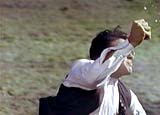The close-up shot utilized in the visual medium can do three things:
1) they can shock your senses into identifying, on a very personal level, with the character within a given moment.
2) they can project emotions, good or bad, with harrowing accuracy- how can you look away?
3) they can provide relief.
For example:


In between these quick cut images of carnage in Arthur Penn's "Bonnie and Clyde", there's a quick second reaction shot when Warren Beatty begins to put two and two together and accepts the idea that a host of lawmen are the cause of the bushes rustling in the near distance. The close-up of Beatty is an understated editing choice that makes the death of these outlaws a little more poignant in what it reflects rather than what it says- a man identifying and accepting that fate has finally caught up with him. The close-up is regretful.
Example 2:

In Andrew Dominik's masterful "The Assassination of Jesse James By the Coward Robert Ford", he alternates between languid long shots of pristine country and intense, somber close-ups that scrutinize so many emotions boiling beneath the surface. In one unflinching scene, the camera holds on Casey Affleck (as Bob Ford) as Jesse James belittles him in front of his family over the dinner table. The shot feels like it goes on forever, intent on framing Affleck's face in the center of the frame as his expression fades from hero-worship to disdain. In that single close-up, motivation and betrayal and character depth are given heavy emphasis. There's more exposition in that one scene than many films strive for during 2 hours. The close-up is confessional.
Example 3:
Comedy. It can be verbal or it can be visual. More often than not, the quick cutaway close-up is of something unmentionable, so its probably better that's its visual. The most recent examples in "Knocked Up" (the "I shouldn't of gone in there..." preceding image) or "There's Something About Mary" (think Franks and Beans....)represent the close-up shot as cathartic laughter. Though often condemned as dirty or crude, these are close-ups that add a dimension to the written word. They don't always work, but when they do, they reach comedy gold. The close-up as relief.
No comments:
Post a Comment